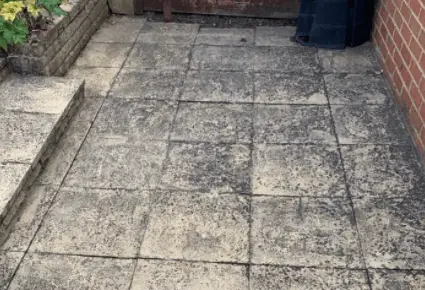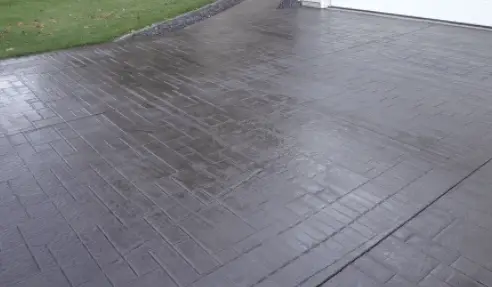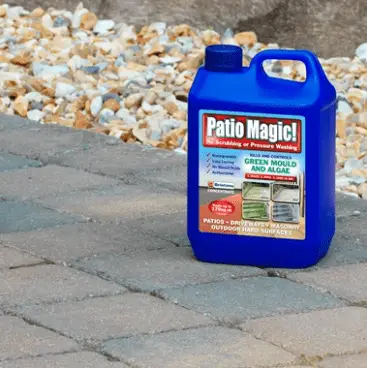Is your concrete driveway spotting black marks that take away its beauty? Looking to restore your discolored sandstone patio back to its former glory? The appearance of black spots on concrete surfaces have always been a huge problem for homeowners.

However, with a little bit more knowledge on the same- you can always undertake a DIY-approach toward concrete black spot removal. Read more on this topic below!
What Causes Black Spots on Concrete?
The most common cause of black spots on concrete surfaces is lichen, which is a composite organism that develops from algae and fungi. Lichen thrives on damp and shaded concrete surfaces.
Lichen are typically blown by the wind onto concrete patios/driveways where they then use their root-like structures to establish themselves firmly onto the stone surface. Even a pressure washer set at maximum pressure is unlikely to remove lichen from your concrete patio.
However, it’s not just lichen that can cause dark spots on concrete surfaces. Water can also cause this kind of stains, especially if you have a malfunction in your drainage and lawn irrigation systems that causes water to spill over into your concrete patio or driveway.
Black mold on concrete will also appear like black spots and marks. Mold forms as a result of persistent moisture and dirt on your concrete surface. Mold is harmful when the spores are inhaled thus important to get it removed immediately.
Another cause of black spots on concrete- most common on newly installed concrete patios/driveways- is poor workmanship, use of low-quality concrete material and use of inconsistent material mixtures. This last cause is- however- not very common.
How do I Get Rid of Black Spots on my Patio?

The best method to apply for black spot removal on concrete patios and driveways will vary depending on the cause.
If it’s water that’s causing black stains on your concrete, you can get rid of the dark spots using an acid rinse or a power washer.
You can then prevent future stains on hardscapes by sealing your concrete using a water repellent sealer or by applying a protective layer of coating such as paint. This will prevent mold, lichens and moss growth on your concrete patio.
Sealing is also an effective way of eliminating dark water marks on concrete surfaces. You can choose between a penetrating sealer and an acrylic sealer with the former being preferred by most homeowners as it doesn’t change the color of concrete surfaces that it’s applied on.
Meanwhile – for black spots caused by poor workmanship during concrete patio/surface installation, you can eliminate them by spraying warm water on the concrete surface and scrubbing repeatedly until the spots disappear. Alternatively, you can acid wash the surface.
If either of these methods don’t work, you may want to consider applying a concrete overlay over the spots. This is simply a cement coating that will blend in with the concrete surface.
Does Bleach Remove Black Spots on Patio?
Yes, bleach can be applied repeatedly to remove black spots off concrete surfaces. In fact, strong bleach (Sodium hypochlorite) is one of the most effective products used to kill lichen on stoned patios.
Sodium hypochlorite possesses twice the potency of regular bleach and you’ll probably need no more than two applications to completely get rid of all the black spots on your concrete.
You will, however, have to be very careful when using this product to get rid of lichen on your hardscapes, as strong bleach is as dangerous as it is effective. It will most likely kill off desirable plants should you inadvertently spill it on nearby lawn areas and gardens.
Utilization of the proper personal protective gear is- therefore- recommended when applying it on your concrete surfaces.
Does Patio Magic Get Rid of Black Spots?

Yes, it does! Patio Magic is a chemical concentrate brand product from Brintons Company that is quite effective at ridding hardscapes of moulds and algae.
It’s also an easy to use product and you won’t have to go through the hassle of scrubbing or power washing your concrete surfaces when using it.
All one has to do is to dilute the concentrate in a plastic container then attach a gardening sprayer to the container. You should then spray the mixture onto the concrete surface ensuring to target the areas with the black spots- then leave it to dry.
Even for hard-to-remove dark spots caused by lichen, you should begin to see positive results after a few repeat applications. Another excellent option that is also highly effective is “30 Second Spray and Walk Away“.
Relatedly, if the above options do not work you can also paint your concrete patio. You can read our detailed guide on painting a concrete patio here.
How do you Get Black Marks off Indian Sandstone?
Indian sandstone patios and driveways are expensive to install- yet- still susceptible to discolouration, just like any other type of concrete/stone surface. When looking to rid your Indian sandstone patio of black spots, you should avoid using any type of acid solutions, as these will cause your slabs to rust.
Instead, you can use soapy water or bleach. For bleach ensure to follow the instructions below:
- Add equal parts water and equal parts household bleach into a container and drench your entire sandstone surface with the bleach solution.
- Next, ensure to work the bleach onto every part of the Indian sandstone surface, specifically targeting the black spots.
- Leave the area for 15 minutes for the bleach to soak in and take effect.
- Finish off the job by using clean water to rinse off the entire patio. The black spots should be gone at this point. If not, a repeat application will do. Alternatively, you can use strong bleach which is three-times stronger- as earlier discussed.
Will Sealing Pavers Prevent Weeds?
Yes, sealing is a good preventive measure for keeping weeds including algae, moss, mold, and lichen at bay on your hardscapes. Sealers typically contain a polymer additive that penetrates into the sand/soil layer in between the patio stones. This polymer hardens the sand/soil mixture, thus making it an unsuitable environment for weed plant growth.
